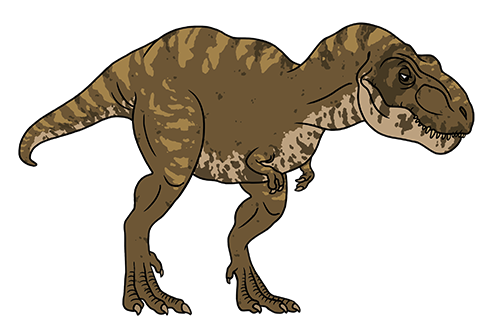Tyrannosaurus rex
#1
by Kyle Morris on October 29, 2021The “tyrant-lizard king” was first discovered in Hell Creek, Montana, in 1902, by paleontologist Barnum Brown. It was later described and given its scientific name by Henry Osborn in 1905. Fossils of this species have been found throughout the western United States and western Canada, including Montana, South Dakota, New Mexico, as well as Saskatchewan and Alberta, Canada.
Weighing over eight tons, this large theropod stood at a minimum height of 13 feet and reached lengths of 40 feet or more. This makes the T. rex (as it is commonly and affectionately known) one of the four largest land carnivores to ever live.
The T. rex is known for its relatively small arms in relation to the rest of its body. However, it is believed that these arms were incredibly muscular. These muscular arms likely aided the animal in raising itself off the ground after resting. Unlike most other theropods, it only had two fingers rather than the usual three.

Artist Rendering of Tyrannosaurus rex
Its mouth was full of dozens of large, serrated, and bone-crushing teeth, many of which were over 6 inches long. In terms of raw power, it’s estimated to have had the strongest bite force of any land animal, living or extinct. Its jaws are thought to have produced up to 14,000 pounds per square inch (psi) of force. For comparison, let’s look at the bite forces of some animals that are still around today.
- Spotted Hyena: 1,100 psi
- Polar Bear: 1,200 psi
- Hippopotamus: 1,825 psi
- American Alligator: 2,125 psi
- Great White Shark: 4,000 psi
This powerful bite allowed the animal to prey on armored dinosaurs such as Triceratops and Ankylosaurus.
Easily the most famous and well-known dinosaur, the T. rex first became popular in 1925 when it appeared in the film The Lost World. After that, it began appearing in other movies, on stamps, as toys, etc. However, it really stole the hearts of many after its star role in 1993’s Jurassic Park. Since then, its popularity has skyrocketed. It is also one of only four dinosaurs to appear in every single Jurassic Park/World film, the others being Velociraptor (though the raptor shown is actually a Utahraptor), Triceratops, and Parasaurolophus.
October is “dinosaur month!” Every weekday of this month, you can come back to our Kids site to read about my 20 favorite dinosaurs. I hope you’ll join me!
- © 2025 Answers in Genesis
- Privacy Policy
- Contact
- About
